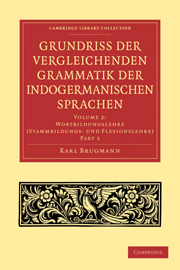Book contents
- Frontmatter
- Vorwort
- Contents
- Verbesserungen und Nachträge
- Wortbildungslehre (Stammbildungs- und Flexionslehre)
- Nominale (und pronominale) Stammbildung und Flexion
- Nominale Zusammensetzung (Nominalcomposita)
- Reduplicierte Nominalbildungen
- Nomina mit stammbildenden Suffixen
- Nomina ohne stammbildende Suffixe (Wurzelnomina)
Nomina mit stammbildenden Suffixen
Published online by Cambridge University Press: 10 November 2010
- Frontmatter
- Vorwort
- Contents
- Verbesserungen und Nachträge
- Wortbildungslehre (Stammbildungs- und Flexionslehre)
- Nominale (und pronominale) Stammbildung und Flexion
- Nominale Zusammensetzung (Nominalcomposita)
- Reduplicierte Nominalbildungen
- Nomina mit stammbildenden Suffixen
- Nomina ohne stammbildende Suffixe (Wurzelnomina)
Summary
Allgemeines
55. Zwischen wurzelhaftem Worttheil und den stammbildenden Suffixen ist, wie bereits I S. 17 f. II S. 3 ff. bemerkt wurde, eine scharfe Grenze nicht zu ziehen. Die Elemente, die wir hier als Stammbildungssuffixe behandeln, mögen zum Theil ursprünglich den Auslaut von Wurzeln d. h. von nicht durch Zusammensetzung entstandenen Wortformen, gebildet haben, und zwar entweder so, dass sie ihrem ganzen Lautkörper nach, oder so, dass nur ihr Anfangstheil zur Wurzel gehörte. Auf Vermutungen darüber, welche von den idg. Suffixen im Einzelnen solchen Ursprungs seien, lassen wir uns nicht ein.
Wir behandeln im Folgenden nur die Geschichte solcher Suffixe, die bereits als fertige Suffixe in das Einzelleben der idg. Sprachen hereinkamen.
56. Viele ihrer Bedeutung nach einheitliche Stammbildungssuffixe lassen sich in mehrere Bestandtheile zerlegen, z. B. -tro- in -tr- + -o-, vgl. ai. ari-tra- m. n. ‘Ruder’ neben ari-tar- ari-tr- m. ‘Ruderer’ (§ 62), -is- + -to-, vgl. ai. náv-iṣṭha- ‘novissimus’ neben náv-yas- ‘novior’ (§ 81).
Solche zusammengesetzte Suffixe sehen wir in jüngeren Sprachperioden hauptsächlich auf drei Arten entstehen.
Einmal dadurch, dass ein Wort oder eine Wortkategorie in eine andre Declinationsclasse hinübergeführt wird. Das Stammbildungssuffix erhält dann einen Zuwachs in der Richtung nach clem Wortende zu.
- Type
- Chapter
- Information
- Publisher: Cambridge University PressPrint publication year: 2010First published in: 1892



